To provide the responsive, personalized, omnichannel retail experience that today’s digital marketplace demands, brands are turning to composable commerce. Learn more about why composable architecture is transforming eCommerce in 2023 and beyond.
eCommerce is a rapidly evolving space, with continued shifts in consumer demand for personalized, interactive, and omnichannel experiences that touch consumers across multiple digital channels. To meet these demands, eCommerce platforms are becoming increasingly made up of modular components – a composable architecture approach that helps retailers adjust with interchangeable building blocks.
This guide will detail what is composable architecture, what are the advantages of composable commerce, various examples of a composable commerce platform, and how composable can be understood in the context of other eCommerce trends, including omnichannel retailing, microservices, and headless architecture.
What is Composable Commerce?
Composable commerce leverages MACH architecture to allow for independent, best-of-breed components or services to be put together to create a flexible and customizable digital commerce ecosystem. Composable commerce architecture emphasizes:
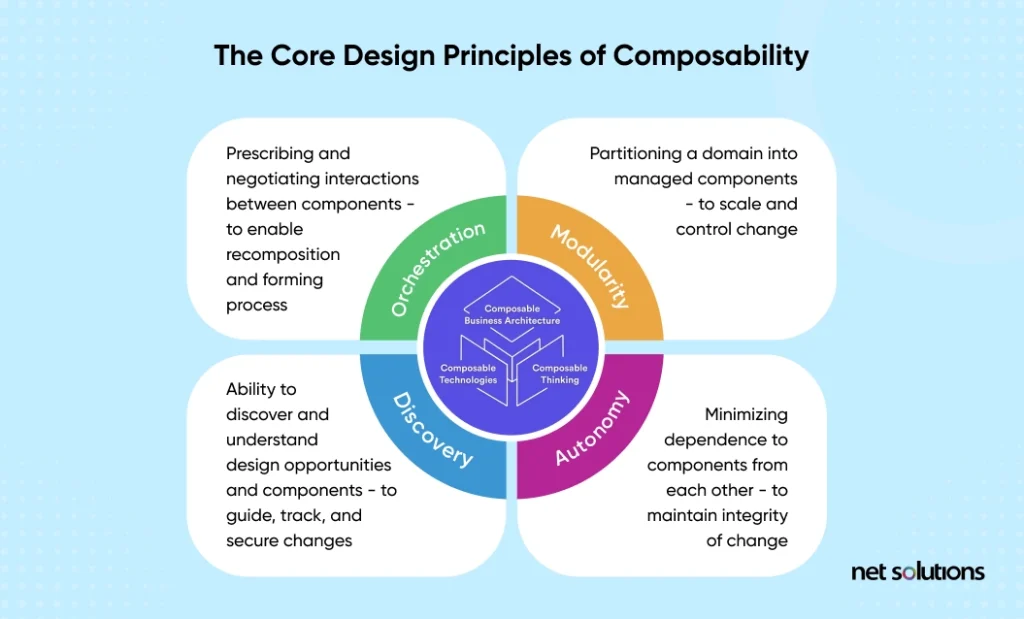
Composable commerce is:
- Business-centric – brands can quickly respond to changing needs quickly and efficiently and can deliver highly personalized experiences to customers across any touchpoint
- Modular – The use of modules or components helps support agility, faster time to market, and flexibility
- Open – Built on open standards, leveraging APIs to integrate with third-party services and replace as needed, with no vendor lock-in.
What is Composable Architecture?
Composable architecture is an approach to software development that leverages individual components and the concept of recomposition to introduce agility and resilience. In 2023, Gartner named composable architecture a “mission critical” element to “master the pace of business change.”
Composable architecture is a more generalized term that means several different architectures. In most cases, composable architecture refers to MACH architecture (M – Microservices, A – API-First, C – Cloud-Native, H – Headless). MACH architecture is the foundation of composable, though composable leverages a slightly different approach to microservices. However, composability can also be applied to the front end, where an architecture approach such as JAMstack (J – JavaScript, A – APIs, M – Markup) can be used.
Composable commerce and microservices
Composable commerce uses modular or composable backend technologies to support an agile architecture. Although at face value, this sounds just like microservices, a composable commerce platform organizes these microservices around business functions or “packaged business capabilities” (PBCs) that can be made up of one or more microservices that include the data, logic, and processes to support each function. PBCs are an outstanding balance between efficiency in flexibility:
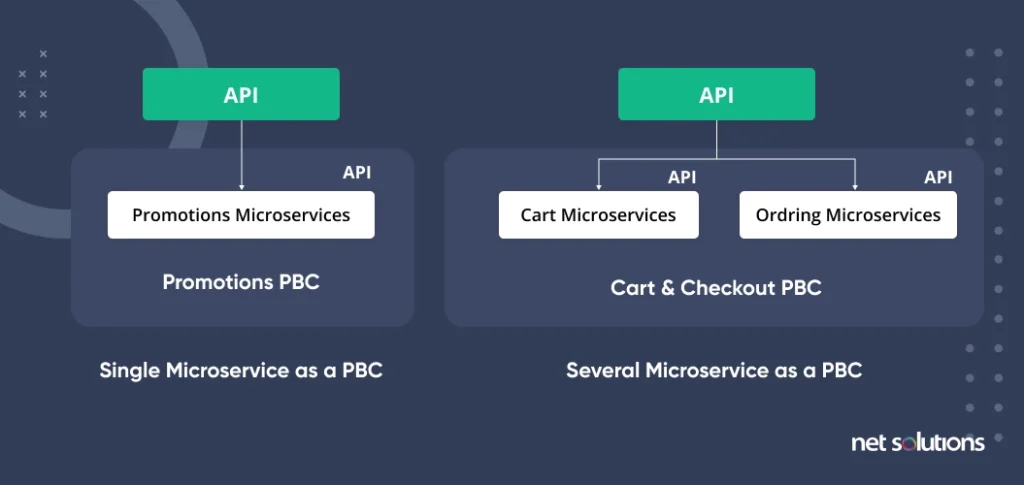
Composable commerce vs. traditional commerce
A traditional eCommerce strategy likely follows traditional or monolithic architecture, often marketed as an “all-in-one” suite or platform. Customization is the premise of composable architecture, allowing eCommerce brands to untie all the features, optimize them as needed, and deliver personalized experiences across an evolving landscape of touchpoints.
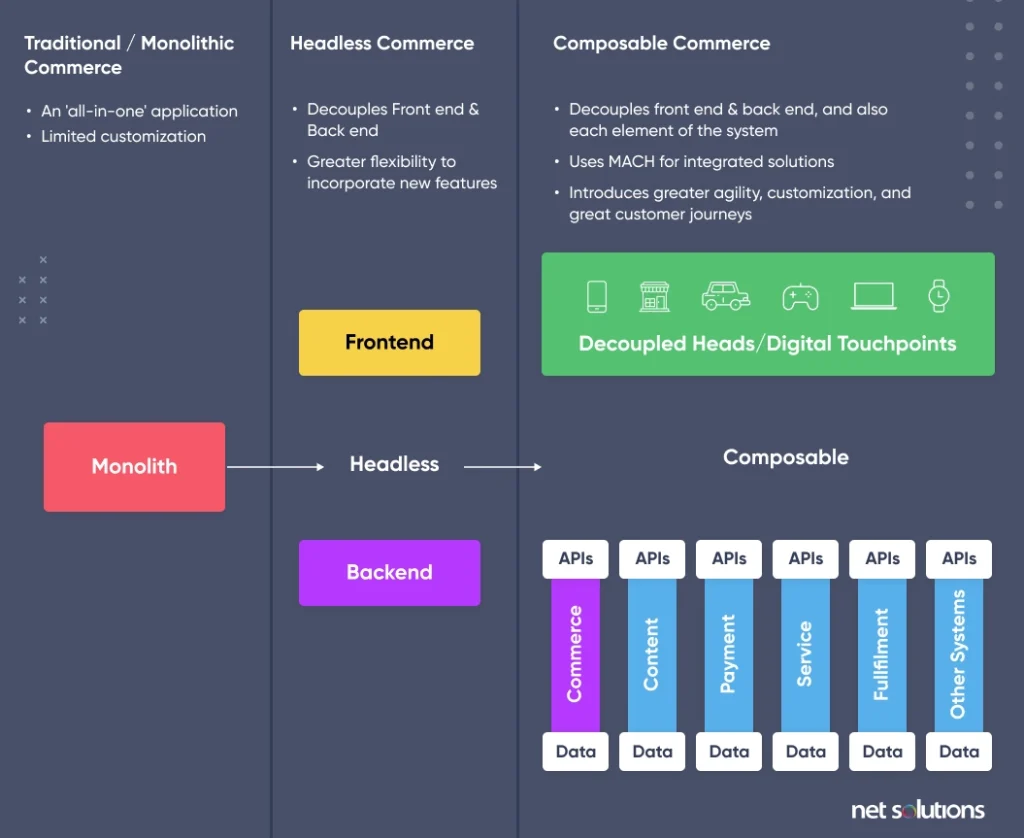
Composable commerce vs. headless commerce
The question often asked is, “Is composable commerce the same as headless.” Headless commerce is an eCommerce platform that separates the front end (user experience / UI) from the back end (functionality, services), connecting the two via API. Headless is one part of a composable commerce strategy, including separated or “modular” / “composable” back-end capabilities.
Examples of composable commerce
What is an example of composable commerce? Composable commerce retail organizations will look for features above and beyond a traditional eCommerce platform. So, in composable commerce, we can think of PBCs around each critical eCommerce function:
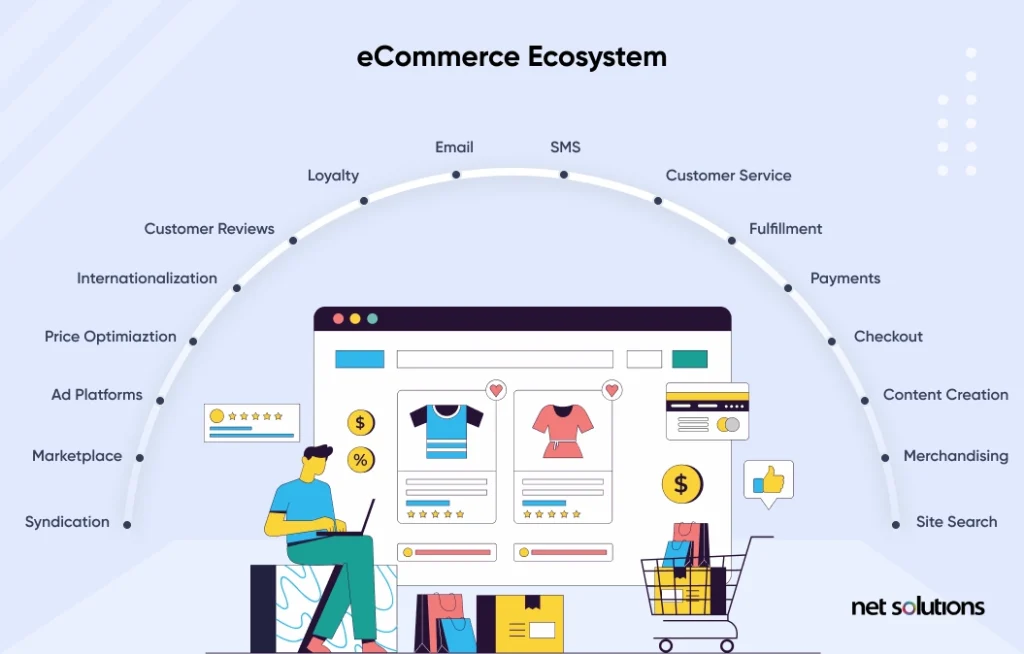
If a retail organization wants to run a subscription service, they may need to consider a third-party subscription service (a PBC) that can be added to the platform to offer these services. For example, a Shopify or Magento platform can be supplemented with the Chargebee or Stripe composable API services.
What are the Advantages of Composable Commerce?
Composable commerce offers several business benefits over traditional commerce platforms, including agility, cost optimization, operational improvement, better scalability/performance, a more flexible ecosystem, and rapid time to market.
Any brand, whether B2C or B2B, can leverage analytics to understand better and segment the customer base, offering improved efficiencies in the marketing and sales funnel and better sales and growth potential. Composable commerce helps accelerate time to market and remain agile to changing customer demands, technology, or new touchpoints. Leveraging the insight from unified data, businesses better understand their customers and their marketing to inform product development and marketing.
- Quick deployment: Composable commerce leverages modular backend to integrate or develop new PBCs
- Operational efficiency: Using PBCs allows brands to integrate services that are ideally suited for the need and scale of the organization, allowing brands to build the right tech stack and not pay for services that are not needed (vs. a monolithic setup). Further, leveraging third-party PBCs offloads some ongoing maintenance needs to third parties.
- Resiliency: MACH architecture introduces system resiliency since any update or service interruption in one system will not take down the entire eCommerce platform.
- Scalable: Leveraging the cloud, PBCs can independently scale to meet demand. Further, this scalability is achieved globally and at new touchpoints with greater flexibility.
How is Composable Commerce Relevant to Omnichannel Strategy?
Today’s consumers can buy in many ways: in-person, on a website, an app, or directly on social media platforms. Traditionally, if you purchased something in-store, the digital platform(s) would not know as each platform is independently run. This “multi-channel” approach is being replaced by one that is “omnichannel,” where omni refers to “all things,” the root of the word omniscient, “knowing everything.” Omnichannel strategies embrace the knowledge of all interactions between a consumer and a brand. Want to learn more about omnichannel vs. multichannel retailing?
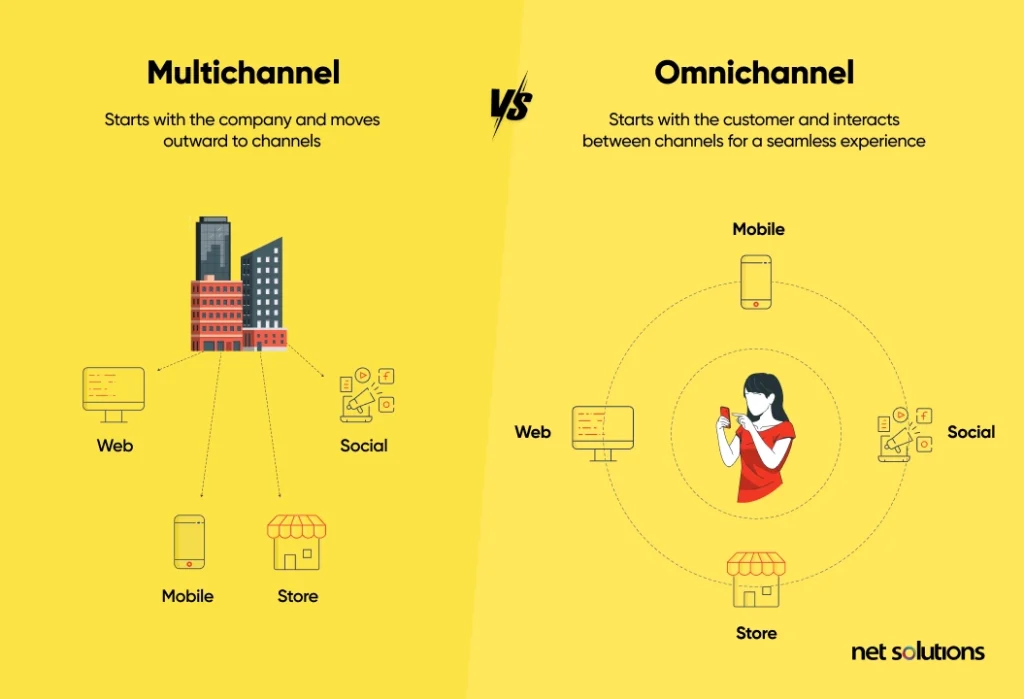
A composable commerce platform helps retail organizations with the agility and customizability they need to meet the growing demands of customers for a personalized, omnichannel experience.
Let’s go over the benefits of composable commerce retail in these points:
1. Unified data management
Easily collect, aggregate, and synchronize data from multiple touchpoints (sales channels) and systems (e.g., inventory management, CRM) to get a more holistic picture of the customer, inventory levels, and order status.
2. Seamless integration with third-party services
Composable commerce is open, allowing brands to choose or change the technology stack as needed (no vendor lock-in) and allowing for rapid innovation.
3. Personalization at scale
Personalized marketing requires in-depth data to resonate with customers. Suppose a customer makes a purchase or considers a product. The opportunity exists to personalize future experiences with chatbots, emails, or changing inventory presentations to provide a better shopping experience. Composable commerce leverages data and innovative technology to make this possible at scale.
4. Real-time inventory management
A PBC such as Kibo can offer real-time inventory management and order routing synced across all digital challenges, marketplaces, and locations.
5. Consistent branding and messaging
Meet the demand for an omnichannel digital experience by syncing data across touchpoints so that messaging can be evolved and/or consistent based on customer interactions and information (e.g., location).
6. Analytics and insights
Creating a unified data store is the first step; the next step is choosing the right tools to transform that data into meaningful insight and action (personalization). Tools such as Google Cloud’s Looker product help deliver tailored insights.
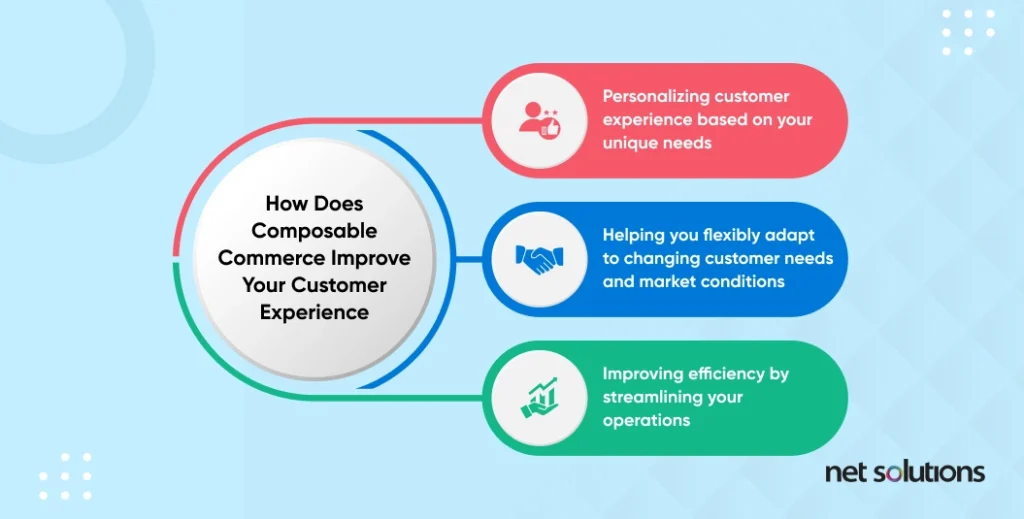
Future for Composable Commerce and How Net Solutions can help
Composable commerce is the future – or at least it empowers the future. The ability to be future-proof to change is the core of composable commerce. So, no matter what trend comes to eCommerce – sustainability, subscription, VR even – composable commerce can support it.
At Net Solutions, we understand that eCommerce success requires using data and analytics to make informed decisions about how and when to innovate. Further, it’s never just about the tools but about using the right tools to their fullest potential. That’s precisely what we specialize in. Our professional eCommerce development services include strategy, composable commerce development, and experienced UX design services.
Frequently Asked Questions
Composable commerce is most suitable for businesses with more complex needs or who operate in a more changeable marketplace. These businesses benefit most from the ability to change PBCs or scale as needed. Simple or low-budget needs remain best served by traditional eCommerce.
Businesses need IT skills to manage the complexity of integrating and managing multiple PBCs to ensure interoperability and realize the benefits of a shared data store. Organizations that require these skills should consider an experienced digital commerce partner.
Composable commerce isn’t just a technical definition. It offers a unique approach to digital commerce. The main principles are that it is modular, business-centric, offers flexibility, and is open.
Any business attempting to adopt Composable Commerce should question itself on its business complexity, digital maturity, and planning for the future state. First, the business would need to know whether it is complex enough to call for a significant shift in technology. Second, is there reasonable digital maturity to invest in new technologies? And lastly, the future opportunities for the brand as the business adopt a new architecture.


